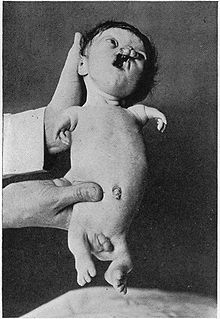Roberts Syndrome
| Classification according to ICD-10 | |
|---|---|
| Q73.8 | Other reduction defects of unspecified extremity (s) |
| ICD-10 online (WHO version 2019) | |
The Roberts syndrome , also Pseudothalidomid syndrome , Appelt-Gerken-Lenz syndrome or Roberts-SC-Phokomelie called, is a very rare autosomal - recessive inherited serious malformation .
Clinical picture
Patients affected by Roberts syndrome have phocomelia (usually tetraphocomelia, i.e. the absence of all four limbs), growth is delayed before and after birth and is characterized by craniofacial malformations and various other malformations. These include, for example, cleft lip and palate , microcephaly with brachycephaly . Furthermore, malformations of the kidneys , heart defects , hyperplasia of the penis ( macropenis ) or the clitoris and various anomalies of the eyes , such as clouding of the cornea, are also observed in many cases . Surviving children very often have intellectual disabilities .
The name pseudothalidomide syndrome can be traced back to the malformations (especially tetraphocomelia) observed in many thalidomide victims , which are very similar to Roberts syndrome.
Epidemiology
Roberts syndrome is a very rare condition. Around 150 cases have been reported worldwide to date.
Etiology and Genetics
Roberts syndrome is caused by mutations in the ESCO2 gene, which is located in humans on chromosome 8 gene locus p21.1. The gene product of ESCO2 , an N-acetyltransferase , which in humans consists of 601 amino acids , plays an important role in cell division in the S phase in the duplication of chromatids . The carrier frequency of the mutation on the ESCO2 gene is unknown. The ESCO2 gene consists of eleven exons with 30.3 kb .
Treatment and prognosis
Most children with Roberts syndrome are stillborn or die very early after birth. However, there are also known cases in which affected children developed normally mentally. The treatment of the patients varies greatly from person to person and is essentially aimed at corrective measures from various medical fields in order to improve the quality of life . The measures include, among other things, surgical interventions of a cosmetic and reconstructive nature, for example in the case of a cleft lip and palate, and early hand surgical corrections to promote the development of grasping. Heart defects and kidney dysfunction are treated symptomatically.
Initial description
Roberts syndrome is named after the American surgeon John Bingham Roberts (1852-1924), who first scientifically described this syndrome in 1919. In 1966 the German geneticists Hans Appelt , Hartmut Gerken and Widukind Lenz described a case of the syndrome, which has now largely been forgotten, which is why the synonymous term Appelt-Gerken-Lenz syndrome is used for Roberts syndrome.
Individual evidence
- ↑ DA Musfeld, EM Bühler, S. Heinzl: Roberts-SC-Phokomelie- or Pseudothalidomid-Syndrom. In: Gynäkologische-Obstshilfliche Rundschau Volume 41, Number 1, 2001, pp. 3–7, doi: 10.1159 / 000049454
- ↑ UniProt: Q56NI9 (ESCO2 HUMAN). Retrieved January 12, 2011
- ^ Roberts syndrome. In: Online Mendelian Inheritance in Man . (English)
- ↑ JL Stone: John Bingham Roberts and the first American monograph on human brain surgery. In: Neurosurgery Volume 49, Number 4, October 2001, pp. 974-984, ISSN 0148-396X . PMID 11564261 .
- ^ JB Roberts: A child with double cleft of lip and palate, protrusion of the intermaxillary portion of the upper jaw and imperfect development of the bones of the four extremities. In: Ann Surg . Volume 70, 1919, pp. 252-254.
- ^ H. Appelt, H. Gerken and W. Lenz: Tetraphocomelia with cleft lip and palate and clitoral hypertrophy - a syndrome. In: Pediatr Paedol. Volume 2, 1966, p. 119.
further reading
- Review article
- M. Mordillo, H. Vega, EW Jabs: Roberts Syndrome. In: RA Pagon et al. a. (Editor): GeneReviews. University of Washington, Seattle, 1993-2006, PMID 20301332
- SA Temtamy, S. Ismail, NA Helmy: Roberts syndrome: study of 4 new Egyptian cases with comparison of clinical and cytogenetic findings. In: Genetic counseling (Geneva, Switzerland) Volume 17, Number 1, 2006, pp. 1-13, ISSN 1015-8146 . PMID 16719272 . (Review).
- M. Urban, C. Opitz et al. a .: Bilaterally cleft lip, limb defects, and haematological manifestations: Roberts syndrome versus TAR syndrome. In: American journal of medical genetics Volume 79, Number 3, September 1998, pp. 155-160, ISSN 0148-7299 . PMID 9788553 . (Review).
- AK Sinha, RS Verma, VJ Mani: Clinical heterogeneity of skeletal dysplasia in Roberts syndrome: a review. In: Human heredity Volume 44, Number 3, 1994 May-Jun, pp. 121-126, ISSN 0001-5652 . PMID 8039795 . (Review).
- DJ Van Den Berg, U. Francke: Roberts syndrome: a review of 100 cases and a new rating system for severity. In: American journal of medical genetics Volume 47, Number 7, November 1993, pp. 1104-1123, ISSN 0148-7299 . doi : 10.1002 / ajmg.1320470735 . PMID 8291532 . (Review).
- P. Iannetti, CE Schwartz et al. a .: Norman-Roberts syndrome: clinical and molecular studies. In: American journal of medical genetics Volume 47, Number 1, August 1993, pp. 95-99, ISSN 0148-7299 . doi : 10.1002 / ajmg.1320470120 . PMID 8368261 . (Review).
- Original research
- A. Al Kaissi, R. Csepan et al. a .: Femoral-tibial-synostosis in a child with Roberts syndrome (Pseudothalidomide): a case report. In: Cases journal Volume 1, Number 1, 2008, p. 109, ISSN 1757-1626 . doi : 10.1186 / 1757-1626-1-109 . PMID 18710560 . PMC 2542345 (free full text). ( Open access )
- J. Khandrani et al: Anesthetic care of Roberts syndrome: A Case report. In: The Internet Journal of Anesthesiology ISSN 1092-406X Volume 24, Number 2, 2010
Web links
- Roberts syndrome (English)
- Roberts' pseudothalidomide syndrome Who named it? (English)
- John Bingham Roberts Who named it? (English)
